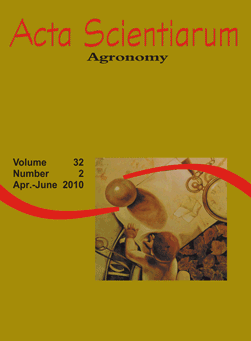<b>Biometric aspects of fruit and seeds, moisture content and overcoming of the dormancy in jatoba</b> - DOI: 10.4025/actasciagron.v32i2.3681
Keywords:
Hymenaea courbaril, forestry species, seedling emergence
Abstract
This study aimed to characterize biometrical seeds and fruits of Hymenaea courbaril L., determine the moisture content and assess different treatments to overcome dormancy. Fruit biometry, mass of fruits and seeds, and the number of seeds per fruit were determined. The seeds were submitted to the following treatments: 1-control, without cutting or scarification, 2-scarification on three sides, 3-cut in half and 4-cut in four parts. The percentage of emergence, emergence speed index, length of the buds and root of seedlings were also evaluated. So, the seeds were submitted to overcome dormancy, with and without soaking in water, represented by the following treatments: I-scarification on the opposite side of the hilum, II-scarification on one lateral side; III-scarification on two lateral sides; IV-scarification on one lateral side and on the opposite side of the hilum, V-scarification on two lateral sides and on the opposite side to hilum; VI-control without scarification. The length, width, diameter and the average mass of fruit were 115.7mm; 62.18mm, 43.8mm and 183.85g, respectively. For the determination of moisture, the seed should be cut in at least two parts. Scarification, regardless of position in seed, with or without soaking in water, allows greater physiological quality.Downloads
Download data is not yet available.
Published
2010-04-27
How to Cite
Andrade, L. A. de, Bruno, R. de L. A., Oliveira, L. S. B. de, & Silva, H. T. F. da. (2010). <b>Biometric aspects of fruit and seeds, moisture content and overcoming of the dormancy in jatoba</b> - DOI: 10.4025/actasciagron.v32i2.3681. Acta Scientiarum. Agronomy, 32(2), 293-299. https://doi.org/10.4025/actasciagron.v32i2.3681
Issue
Section
Crop Production
DECLARATION OF ORIGINALITY AND COPYRIGHTS
I Declare that current article is original and has not been submitted for publication, in part or in whole, to any other national or international journal.
The copyrights belong exclusively to the authors. Published content is licensed under Creative Commons Attribution 4.0 (CC BY 4.0) guidelines, which allows sharing (copy and distribution of the material in any medium or format) and adaptation (remix, transform, and build upon the material) for any purpose, even commercially, under the terms of attribution.
2.0
2019CiteScore
60th percentile
Powered by 

2.0
2019CiteScore
60th percentile
Powered by 



















































